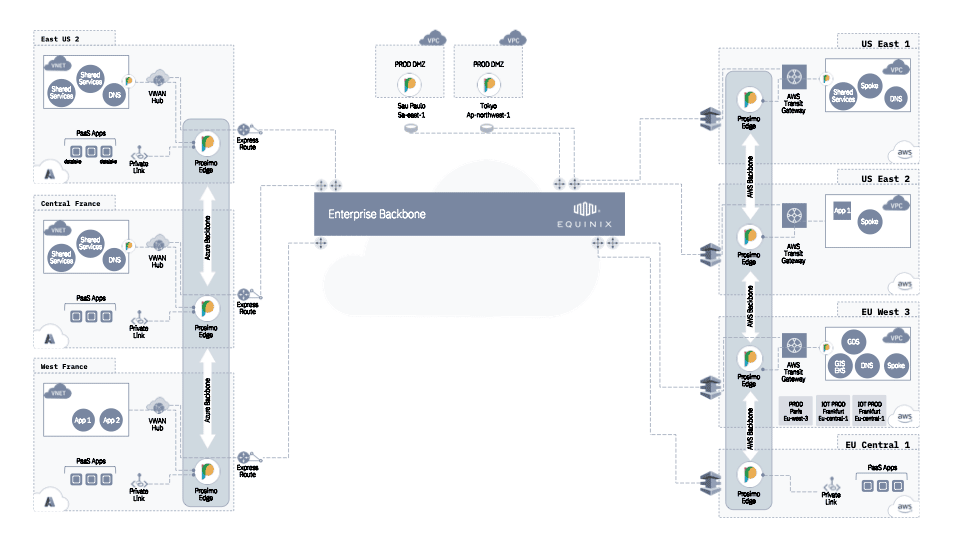Fortune 500 energy company simplifies multi-cloud networking with Prosimo.
CASE
STUDY
Prosimo Full Stack Cloud Transit allowed the company to accelerate its cloud journey and deliver reliable, fast, and secure experiences to users wherever business takes them.
Key Challenges

Utilize GCP cloud-native services such as Cloud Interconnect, Cloud Router, and Private Service Connect as an underlay.
Manage access to multiple business units accounts in GCP through a single pane of glass.
Simplify management of stacks and dashboards, while improving visibility of traffic flow between endpoints, VPCs, and accounts across regions and data centers.
Ensure high-performance traffic encryption for network traffic.
Simple cloud networking

Prosimo AXI allows the company to consolidate network visibility and control on a single dashboard—saving time and money.
Consistent application experiences
Prosimo enables reliable, fast, and secure application experiences across multi-cloud environments—giving employees, partners, and other stakeholders access to the tools and information they need to make good decisions quickly.
Reduced attack surface
Better end-to-end observability across CSPs and internal data centers allow security teams to identify abnormal behavior and take appropriate action to stop malicious actors. Security policies and controls are also applied consistently and appropriately regardless of the underlying infrastructure.
Reduced cloud spend
Consolidating network services through Prosimo eliminates the need to endlessly deploy virtual appliances in CSP environments to keep up with demand—saving cloud spend.
“Prosimo allows us to easily take advantage of the infinite resources of the cloud. We have big plans to change the way energy is managed around the world. We now have the infrastructure to accomplish great things.” - Director of cloud platform
The Need for Dynamic Cloud Architecture
Emerging markets are a case study of business volatility. The difference between carving out a sizable market share and failing to make an impact is razer thin. Success largely hinges on making the right decisions at the right time, while missed opportunities have an outsized impact on the company’s viability.
For one Fortune 500 company in the energy business, transitioning to a software company that helps utilities, manufacturers, and building owners digitally transform their operations to be more efficient and sustainable would require a new level of business agility. Despite being in business for nearly 200 years, the company needed to accelerate software development, adopt and roll out new technologies, explore new markets worldwide, and investigate and integrate acquisition targets that would help the company speed growth.
The move to the cloud was a no-brainer, and, over the course of several years, the company migrated critical business systems to a multi-cloud environment across a dozen Azure, AWS, and GCP regions worldwide. A truly cloud-based business, the company prioritized application access to employees, partners, and other stakeholders wherever business took them.
Do It Yourself Approach to Cloud Networking Falls Short
The company’s DIY approach to cloud connectivity and networking worked well early in the company’s cloud transformation journey. A team of cloud architects and cloud operators manually stitched together multiple services from various cloud service providers (CSPs), such as virtual appliances, security tools, and load balancing. Cloud-to-cloud and cloud-to-data center connectivity was done by tunneling through various VPNs and firewalls. However, the resulting networking sprawl and decentralized policy management required constant attention from multiple cloud operations teams, stretching already overworked teams even thinner.
Complexity also bred performance and security issues. A lack of visibility across cloud regions and CSPs prevented optimal routing and the identification and troubleshooting of tunneling bottlenecks. In addition, expanding threat surfaces blocked operators from effectively monitoring workloads, performance, availability, user behavior, and analytics—increasing security risk. As the company’s cloud footprint expanded to other regions and new acquisitions were coming on board, the company’s director of cloud platforms realized that this DIY approach was unsustainable.
“We were having trouble replicating the success of our early cloud deployments,” he said.
“We needed consistent, repeatable architecture that we could spin up and down to meet whatever demand came down the pipeline. We just couldn’t keep going to our networking and security teams with all these demands that needed to be done right then. We needed to be more flexible, more dynamic, and enable the level of agility our corporate leadership was asking of us.”
A Complete Rethinking of Networking
The director of cloud platform investigated several ways to simply multi-cloud networking across the organization’s global operations—looking at traditional SD-WAN and MPLS vendors to consolidate infrastructure. He also considered traditional layer three networking approaches but decided a complete rethinking of how to approach networking was needed. And that brought him to Prosimo.
Born in the cloud, Prosimo Application eXperience Infrastructure (AXI) integrates with existing cloud-native network constructs to maintain a direct path to application endpoints while enhancing security and performance. The company’s cloud architects and operations teams can now create secure connectivity to applications deployed across dozens of Azure, AWS, and GCP environments worldwide. Scaling to other regions is done in a matter of minutes by dropping a Prosimo Edge to that region with Prosimo automatically taking care of all the plumbing orchestration, providing the right level of visibility and control.
Automating multi-cloud networking with Prosimo centralizes multi-cloud networking through a single management console. Cloud operators simply spin up an instance, and set service level agreement (SLA) requirements based on performance, security, reliability, and cost—and users can get up and running within minutes. Optimal routing and content caching on the edge boost performance without requiring additional cloud resources.

Impact and outcomes
Creating and maintaining the company’s multi-cloud environment is now much easier for cloud architects and operations teams. Instead of using an assortment of tools across CSPs, the company has centralized networking on a single dashboard, saving enormous hours and allowing them to focus on more strategic tasks.
Security is also enhanced through better visibility into application and user behavior, allowing security teams and AI/ML-powered threat intelligence to identify abnormal behavior and take necessary countermeasures. Enterprise security policies are created and managed from a central dashboard and automatically applied to workloads regardless of the underlying infrastructure. Segmentation built into the Prosimo platform prevents lateral spread.
Simplicity also saves on cloud spending. The company is no longer required to deploy networking services such as load balancers and VPN gateways in the cloud since everything is consolidated in Prosimo. It’s a much simpler and vastly less expensive pricing model.
